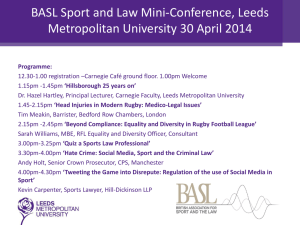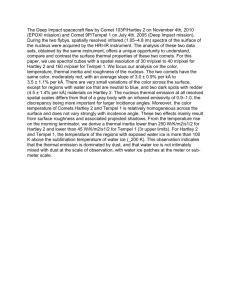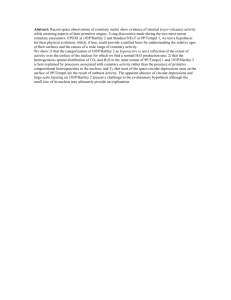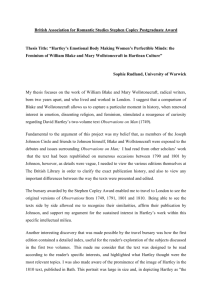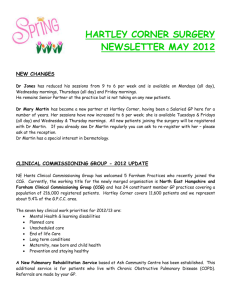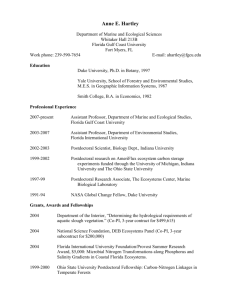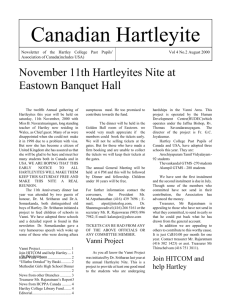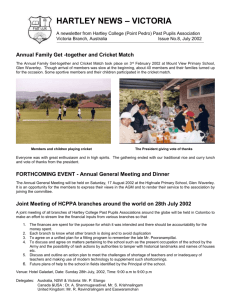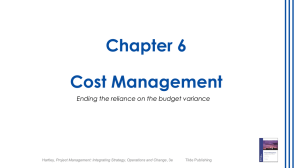How to write a book review* - My.Anglia Homepage
advertisement
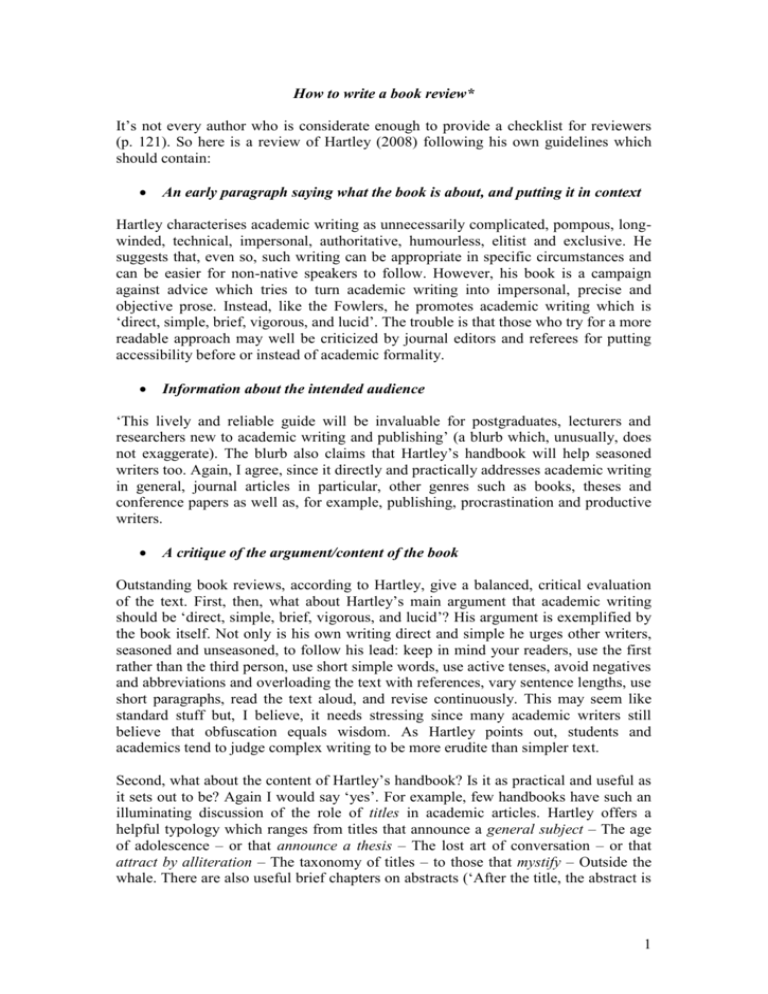
How to write a book review* It’s not every author who is considerate enough to provide a checklist for reviewers (p. 121). So here is a review of Hartley (2008) following his own guidelines which should contain: An early paragraph saying what the book is about, and putting it in context Hartley characterises academic writing as unnecessarily complicated, pompous, longwinded, technical, impersonal, authoritative, humourless, elitist and exclusive. He suggests that, even so, such writing can be appropriate in specific circumstances and can be easier for non-native speakers to follow. However, his book is a campaign against advice which tries to turn academic writing into impersonal, precise and objective prose. Instead, like the Fowlers, he promotes academic writing which is ‘direct, simple, brief, vigorous, and lucid’. The trouble is that those who try for a more readable approach may well be criticized by journal editors and referees for putting accessibility before or instead of academic formality. Information about the intended audience ‘This lively and reliable guide will be invaluable for postgraduates, lecturers and researchers new to academic writing and publishing’ (a blurb which, unusually, does not exaggerate). The blurb also claims that Hartley’s handbook will help seasoned writers too. Again, I agree, since it directly and practically addresses academic writing in general, journal articles in particular, other genres such as books, theses and conference papers as well as, for example, publishing, procrastination and productive writers. A critique of the argument/content of the book Outstanding book reviews, according to Hartley, give a balanced, critical evaluation of the text. First, then, what about Hartley’s main argument that academic writing should be ‘direct, simple, brief, vigorous, and lucid’? His argument is exemplified by the book itself. Not only is his own writing direct and simple he urges other writers, seasoned and unseasoned, to follow his lead: keep in mind your readers, use the first rather than the third person, use short simple words, use active tenses, avoid negatives and abbreviations and overloading the text with references, vary sentence lengths, use short paragraphs, read the text aloud, and revise continuously. This may seem like standard stuff but, I believe, it needs stressing since many academic writers still believe that obfuscation equals wisdom. As Hartley points out, students and academics tend to judge complex writing to be more erudite than simpler text. Second, what about the content of Hartley’s handbook? Is it as practical and useful as it sets out to be? Again I would say ‘yes’. For example, few handbooks have such an illuminating discussion of the role of titles in academic articles. Hartley offers a helpful typology which ranges from titles that announce a general subject – The age of adolescence – or that announce a thesis – The lost art of conversation – or that attract by alliteration – The taxonomy of titles – to those that mystify – Outside the whale. There are also useful brief chapters on abstracts (‘After the title, the abstract is 1 the most frequently read part of any paper’); selecting key words; introductions; methods; results; discussions; and even on the writing of acknowledgements. Any supporting academic references One of the main features of Hartley’s book is the extent to which he backs up his statements about academic writing by reference to his own work and to that of others. For example, in his opening chapter on the nature of academic writing he cites no less than seven of his own papers on such topics as assessing the effects of new technology on writing, clarity across the disciplines, style and substance in psychology as well as on readability and prestige in scientific journals. He also links his own research with that of others in similar or contrasting disciplines. Noticeable here is a reference to, for example, Murray and Moore (2006) which might be regarded as a rival text on academic writing. Remarks on the strengths and limitations of the book The strengths of the book lie in its clear and direct style, its effective coverage of key topics in academic writing and its scholarly quality. I agree with one referee who describes Hartley’s work as ‘exceptional’ because he ‘speaks out to the reader quite personally, while at the same time conveying useful information, findings and thinking in a scholarly, rigorous and academic manner. This is a rare talent’. Does the book have any limitations? Of course, Hartley could have written more comprehensively about each of the issues he discusses but this might have undermined his concern to avoid an unnecessarily complicated, pompous, longwinded, technical, impersonal and humourless text. And, for those who want more, each chapter ends with helpful suggestions for further reading. Although ‘it is not required that every review contain at least one negative remark’ (p. 117) I will offer a couple of minor complaints in order to avoid becoming too laudatory. First, there is the occasional misrelated participle: ‘Borrowing from Hughes (2005), it might be worth considering selecting words from a series of categories…’ (p. 39); ‘When writing a literature review, one solution to some of these problems is to examine in more detail the original papers…’ (p.91). The eminently Victorian Fowlers would not have been amused. Second, I have a beef about his punctuation of bullet points. In my view the virtue of the bullet point is that its punctuation is upfront in order to attract attention and signal emphasis. Hartley effectively uses this device throughout his text and, indeed, urges consistency in its punctuation for lists (p. 148). However, he and/or his sub-editor fail to meet the need for consistency because the bullet points are variously followed by semi-colons, full stops or nothing at all. I prefer the latter but most of all I urge my own students to be consistent in how they punctuate their lists: A list about the punctuation of bullet points (bps) bps may be punctuated with a semi-colon; bps may be punctuated with a full stop. bps already have their punctuation mark up-front and need no other but shouldn’t bps which are questions have their own question mark? 2 However, of course, in order to make the point, I have had to be inconsistent. Writing is a tough old trade. A note on the format, length and price (or value for money) The handbook has four sections – Introduction, The academic article, Other genres, Other aspects of academic writing – each containing, apart from the relatively long (20 pages) Introduction, a series of brief chapters. There are also three appendices offering guidelines for academic writing, guidelines for revising text and abbreviations for American states used in citing references. Hartley also follows his own advice by keeping his paragraphs short and using helpful subheadings throughout. The length at 196 pages is long enough for relevant material to be covered and short enough to avoid tedium. At £19.99 the paperback represents excellent value for money and I shall be recommending it to all postgraduate students and academics across the disciplines. A note (if appropriate) on how well the text is supported by tables/diagrams/illustrations Here again Hartley exemplifies his own recommended good practice. First, he provides his readers with 19 useful figures such as Reasons for writing, An original abstract in structured form, The author’s response to an editorial request and A typical format for an academic poster. Second, he offers 39 valuable tables including Some characteristics of academic writing, Some rhetorical devices used in academic articles, Titles used by students for their projects, Ten ways to provide effective key words and phrases, Authors from hell versus dream writers, The hidden meanings of phrases in book reviews and Things that writers do to avoid writing… The figures and tables alone, mainly research-based, will be gratefully used by novices and experienced writers, by students and teachers. Graham Badley Research, Development and Commercial Services Anglia Ruskin University August 2008 ------------------------------------------------------------------------------------------------------Hartley, James 1940Academic writing and publishing: A practical handbook 2008 Routledge: London and New York ISBN 13: 978-0-415-45321-9 (hbk) ISBN 13: 978-0-415-45322-6 (pbk) ISBN 13: 978-0-203-92798-4 (ebk) pp. 196 Hardback £75 Paperback £19.99 * Review to be published in PsyPAG Quarterly, December 2008 3

